I wrote this article to share my tips on how to stop a dog from counter surfing. I focused on prevention first and also cover several training tools that work for some dogs. Every dog and situation is different so this post is meant to help you brainstorm what might work best for your specific dog.
Dogs who counter surf are mostly just annoying. However, a dog’s counter surfing can also be downright dangerous!
Think of chocolate cake, heavily seasoned steak or how about that strawberry champagne punch for your summer party. All three can end really badly depending on the dog’s size and how much makes it into his tummy.
Certain spices, chocolate, and alcohol are toxic to dogs and can cause gastrointestinal upset, abdominal pain, seizures, drowsiness, and kidney problems, to name just a few health issues.
In this post, you’ll find advice on:
- Preventing a dog from stealing food
- How to stop a dog from jumping on the counter
- Stop dog from stealing food when home alone
- Tools to stop a counter surfing
- E-collar to stop counter surfing
- Mousetraps to stop counter surfing
Prevention as key to stop a dog’s counter surfing
Let’s first determine WHY your dog might be interested in exploring your kitchen counters and dining room table in the first place.
The two main culprits are usually:
- boredom
- lack of training
If we mix that with a dog’s innate curiosity and opportunistic food drive, we’re dealing with a first class acrobatic doggie thief!
That’s why our first piece of advice is to never form the habit of counter surfing to begin with
This is particularly easy to implement when your dog joins you as an impressionable young puppy, but any dog regardless of age and background can be reconditioned.
Prevent counter surfing through:
- Kennel training
- Not leaving food out
- Exercise
When I adopted my dog Wally, he was a little over one year old and had a few behavioral issues, one of them being counter surfing.
I implemented the strict policy of not leaving any food out throughout the house, and that fixed the problem very quickly along with daily exercise, a routine, and one particular tool.
Note that it’s important to be consistent in your approach and to offer your dog structure in his daily life. It’s your job to show him what you expect of him, and to guide him on that journey.
Kennel training to prevent counter surfing
At That Mutt, we believe in kennel training because kennels keep our dogs safely confined and out of trouble when we can’t watch them.
When you know you’ll be busy preparing dinner in your kitchen and your counters are lined with food too tempting for your dog, we suggest crating him during that time (for now).
Consider putting his crate up within your line of sight, that way he won’t feel left out. Give him a tasty chew to keep him entertained while he’s crated, and he’ll be a happy camper. This could be a bully stick or a frozen dog food puzzle for ultimate chewing fun.
Simply fill a KONG dog toy with your dog’s food, freeze overnight, then offer it on the “special” crating occasion.
The KONGs come in different rubber strengths for puppies, medium chewers and strong chewers. Your pup will soon learn to look forward to being crated with his special chew while you’re busy in the kitchen.
Tip: You can bring your dog’s crate along when visiting friends and family with your pooch. Most of the wire crates fold down for easy transporting.
If you’d like to learn more about crate training, check out our article:
If crating your dog doesn’t work for you, you could leash your dog when you’re busy in the kitchen and attach the leash to a furniture leg or other sturdy alternative such as a railing. Some dogs may do best with a chew proof leash.
Additionally, teach him the command place and associate his dog bed with it. Have him go to his place while you’re busy in the kitchen and stay there.
See our post: Teach your dog the place command.
We also strongly believe in not leaving food out within your dog’s reach
This method is extremely effective as there simply won’t be any food there for your dog to take! Eventually, your dog will begin to understand that he won’t get “rewarded” with anything for jumping up onto the kitchen counter or dining table. However, this will require a consistent effort on your part in order to sink into your dog’s brain.
You’ll have to make sure that your entire family is on the same page, and to communicate your house rules to visitors and guests as well, especially around the holidays when there’s an abundance of food. You may also need to put dirty dishes in the dish washer right away vs. leaving them in the sink.
Lindsay used to have a cat named Beamer who would steal anything off the counters. I mean anything!
Beamer would eat avocados, used paper towels, potatoes, apples. Things you would not expect a cat to get into. Well, guess what? Lindsay learned never to leave any food out, and this helped her young puppy Remy as well. Remy never learned the habit of counter surfing since there was never anything available to steal!
Also read: How to stop a cat from counter surfing
Another aspect in preventing your dog from counter surfing is exercise
A tired dog is much less likely to misbehave than one who hasn’t been challenged physically and mentally, much like kids are less likely to act up when they’re encouraged to explore the outdoors and be creative.
Physical exercise
I suggest taking your dog outside for several 30- to 90-minute daily exercise sessions. Ideally in the morning, at midday and in the evening.
These sessions could simply consist of structured walks, but you can certainly increase their physical intensity by taking your dog running, biking, rollerblading, swimming and/or adding a doggie backpack to either activity. Wally goes for backpack walks on most mornings.
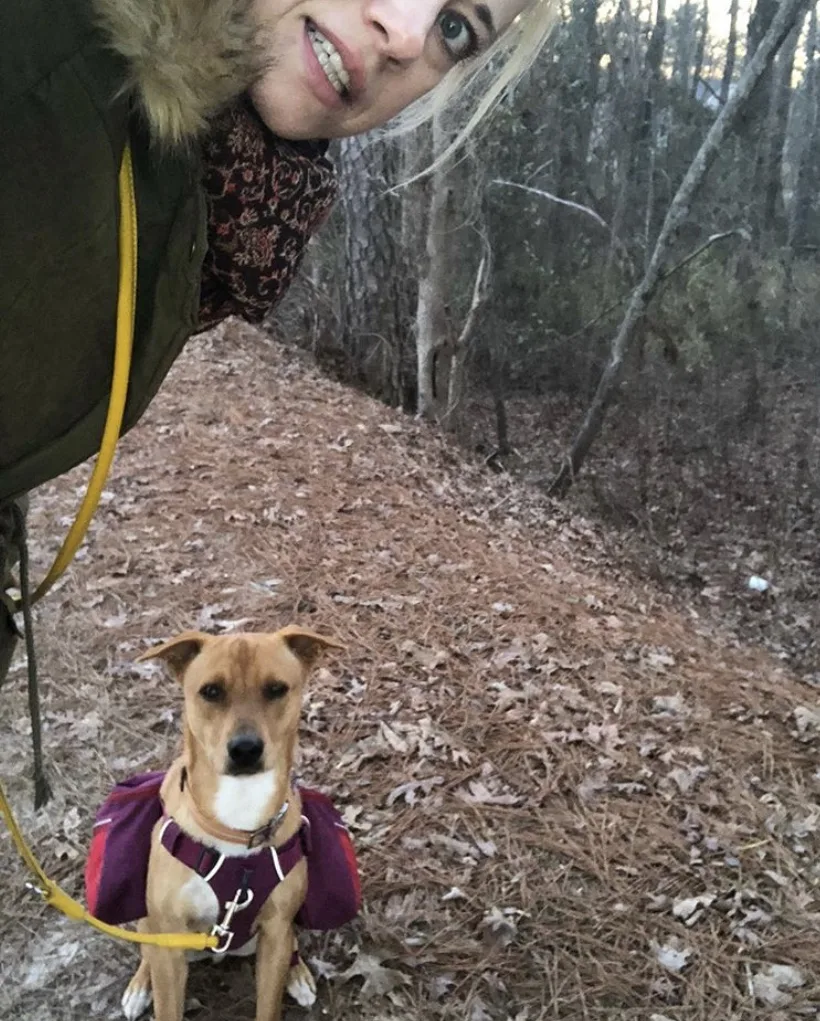
Mental exercise
To challenge him mentally while outside, change directions frequently and incorporate some basic obedience commands or even trick training. You could ask him to sit, lie down, stay, shake, high 5, or anything else that’s in his repertoire. It’ll make him focus on you and tire him out mentally.
Other activities that combine physical and mental challenges are dog specific sports such as agility, tracking, and herding to name just a few. Check with your local dog training facility to see if they offer any of these, or do a quick search online for doggie sports in your general area.
Mental challenges you can expose your dog to inside your home are dog food puzzles, trick training, and playing games like hide and seek. These will come in handy too on days when it’s miserably hot or cold outside. See my post: Day in the life of an active dog for more ideas.
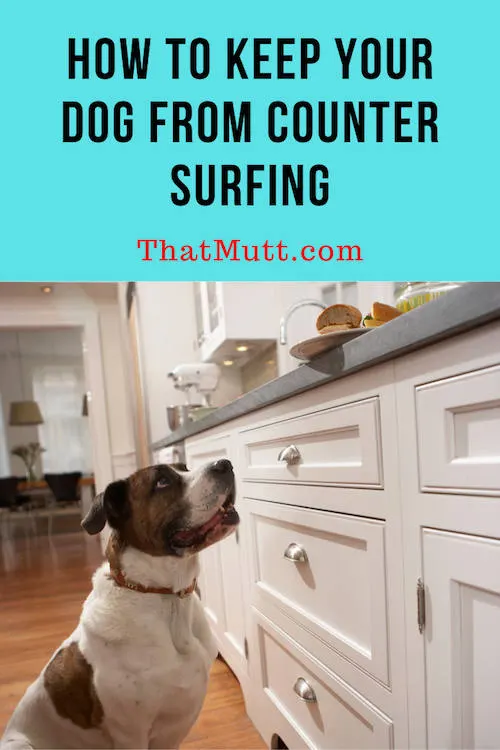
How to stop your dog from jumping onto the table or counter
Counter surfing mainly pertains to medium to large size dogs. Small dogs are more prone to jumping or climbing up onto the actual table since the counter is usually out of their reach.
While the ultimate goal is to eliminate the behavior in its entirety, the immediate goal is to correct the behavior as it’s happening.The following will help achieve that:
Use loud sounds like your voice, clapping, blowing into a whistle or a horn
When I caught my new dog Wally putting his front paws on my kitchen counter on DAY 2 of being with me, I did 3 things to correct the behavior:
1. I addressed the situation verbally with a firm “No” and “Off.” I differentiate between “off” and “down.” “Down” means to actually lie down. “Off” means to get off of the furniture or kitchen counter.
2. I clapped my hands to get his attention and distract him from what he was doing.
3. I put him into a “sit” away from the kitchen counter with all four paws on the ground and praised by saying good boy.
I also pulled out a spray bottle and filled it with water!
I placed a spray bottle onto the kitchen counter for Wally to see it, and gave him a spray whenever he’d attempt to put his paws on there. He really doesn’t like being sprayed with water, which made this an effective tool in conveying the message of keeping his paws off the counter.
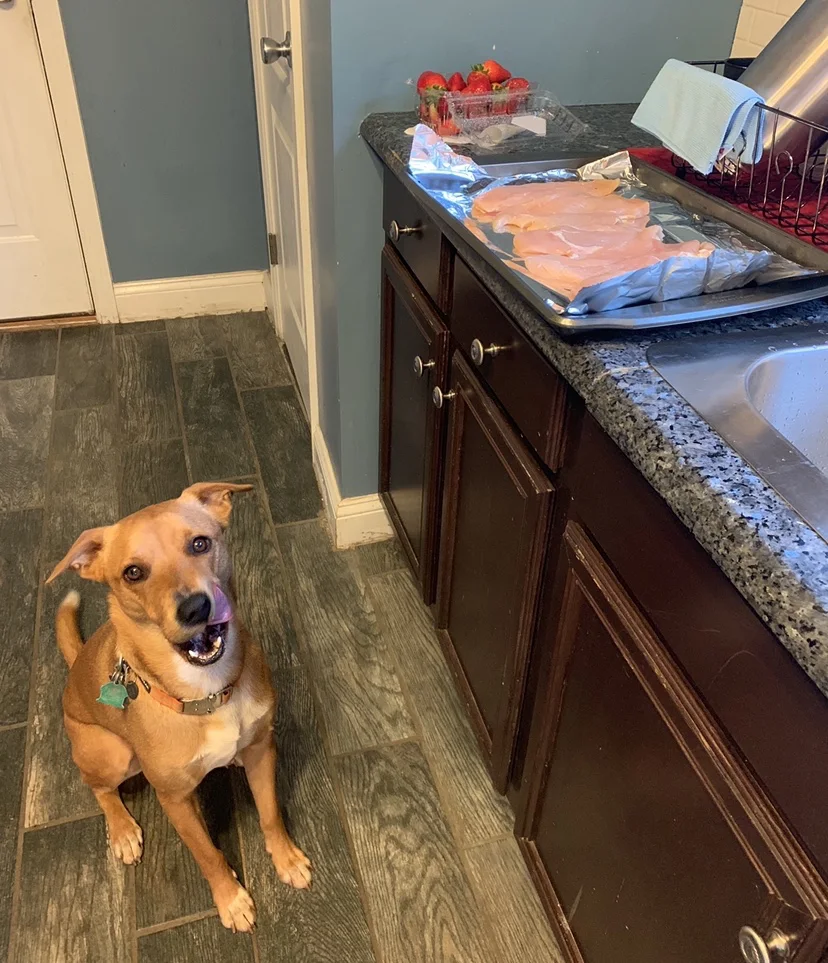
Ultimately, you’ll want to discourage your dog from repeating the behavior, both when you’re around as well as when your dog is home alone.
If you’re not sure how your dog makes it onto your counter or dining table when you’re not there to supervise him, consider setting up a camera to study his behavior, then adjust your training approach accordingly.
How to stop your dog from counter surfing when home alone
Now I’d like to share my top 4 suggestions of how to stop your dog from counter surfing or jumping up onto the dining table when he’s home alone.
1. The most effective way is to confine your dog inside a kennel
As mentioned above, confining your dog inside a kennel is part of a preventative approach in keeping him off your kitchen counter or dining table, especially when he’s home alone and unsupervised. That’s exactly what I did with Wally when he was home alone for the first two months.
For the escape artists who have figured out how to unlatch kennel doors or who’ll chew up plastic or wire crates, there are escape-proof kennels that feature double locks and metal or stainless steel framing.
You could also reinforce kennel doors and corners with zip ties or carabiner clips.
Just remember that kennels aren’t meant to be an all-day prison for your dog. You want to offer your dog regular potty and walking breaks! Also make sure to exercise your dog properly before crating him and give him a safe chew toy while he’s crated. This should leave him calm and not prone to figuring out how to escape his crate.
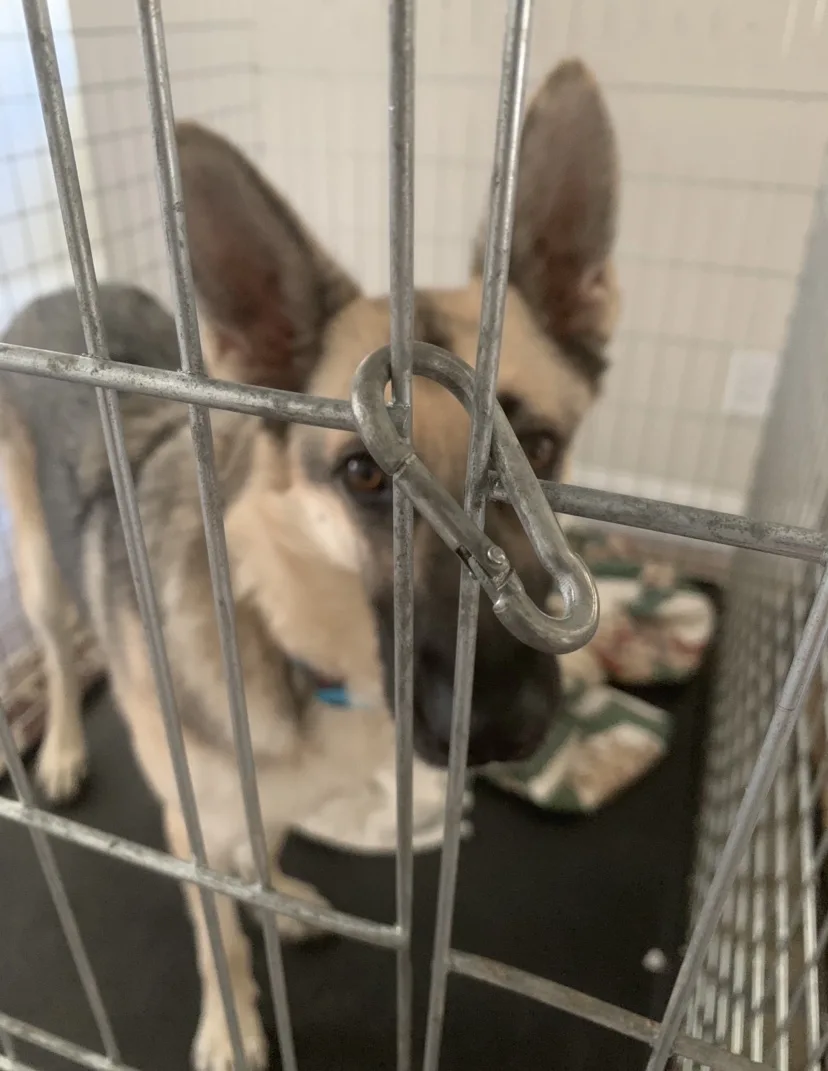
2. Gate the kitchen or dining room area off
If your dog has the run of the house but tends to explore your counters and/or dining table, try creating physical boundaries. Should you have a closed off dining area, simply close the door. In case you don’t, try setting up gates and/or playpens to keep your dog away.
There are a variety of different gates to choose from:
- Plastic, metal, or wood gates
- Regular sized or extra tall gates for jumpers
- Extra wide and adjustable gates
3. Make access to the dining table and kitchen counter hard
In addition to gating your kitchen and dining area off, consider investing in a tall dining table. That’s the approach several of my dog walking clients have taken who have large and extra large dogs (mastiffs, great danes and German shepherds). Keep the chairs pushed all the way under the table so your dog can’t use them as jumping platforms.
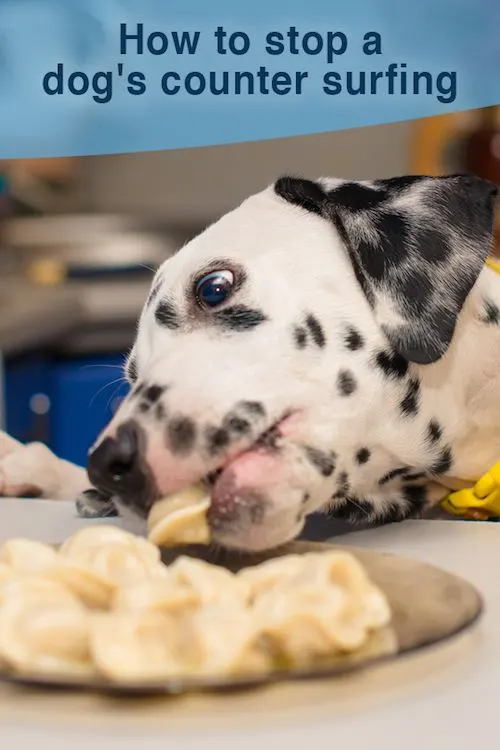
Do the same with bar stools under your kitchen island. Also avoid placing lower furniture like side tables, ottomans or couches near the kitchen island/counter and dining table. Acrobatic pups, especially the smaller ones, might very well be inclined to turn them into jumping platforms that help them jump onto those surfaces!
4. Training tools to stop a dog’s counter surfing
I came up with a few other approaches worth mentioning. They can work for dogs as well as for cats and are easy to implement.
Other tools to stop a dog’s counter surfing:
- Aluminum foil. Dogs neither like the feeling nor the sound of the foil when stepping on it. Consider lining your kitchen counter and/or dining table with it temporarily. You may have to tape it down for it to stay in place. You could use double sided sticky tape for this purpose.
- Double sided sticky tape. The concept behind sticky tape is that dogs don’t enjoy stepping onto a sticky surface. Try taping the edges of your kitchen counter and dining table to see if it will deter your dog from jumping up there.
- Sticky paws products. Comparable to double sided sticky tape. Sticky paws makes transparent tape of various sizes that has a sticky texture dogs don’t appreciate stepping on.
- Scat mats. Scat mats are battery operated, clear vinyl mats that use a three second static pulse when stepped on. They come with three different levels of correction intensity and seem to be working quite well according to their reviews.
The main con of these approaches is that they’re somewhat annoying to put up and then remove once you’re back home and ready to use your kitchen. They’re also not exactly visually appealing, but should be acceptable temporarily while counter-conditioning your dog, pun intended!
More tips to prevent your dog from stealing food
Most dogs are opportunistic food thieves, so it pays off to have strategies in place that prevent them from stealing food. We suggest doing the following to keep your greedy doggie mouths away from your food:
- Put groceries away right away. Dogs are opportunistic and will take advantage of your counters lined with food. Use the place command to keep your dog on his designated doggie bed, leash him, or crate him.
- Keep pantry doors closed and place harmful food on higher shelves as an additional preventative measure. A curious doggie nose can easily nudge a pantry door open that’s left ajar.
- Don’t sneak a dog food from the dining table or while preparing it in the kitchen. If you want to share some with your pup, offer it to him in his regular feeding area.
- Get the entire family on the same page. Otherwise, it will be much harder for your dog to detect a pattern and he’ll be confused as to what’s expected of him.
- Teach a solid leave it command. It’ll come in handy when you need your dog to drop the harmful food you just saw him steal or to keep him from picking up food you just dropped.
- Give your dog high value, long lasting food puzzles that distract him from human food. That way, he won’t feel like he’s missing out.
- Don’t leave dirty dishes out on the counter or in the sink. Put them in the dishwasher.
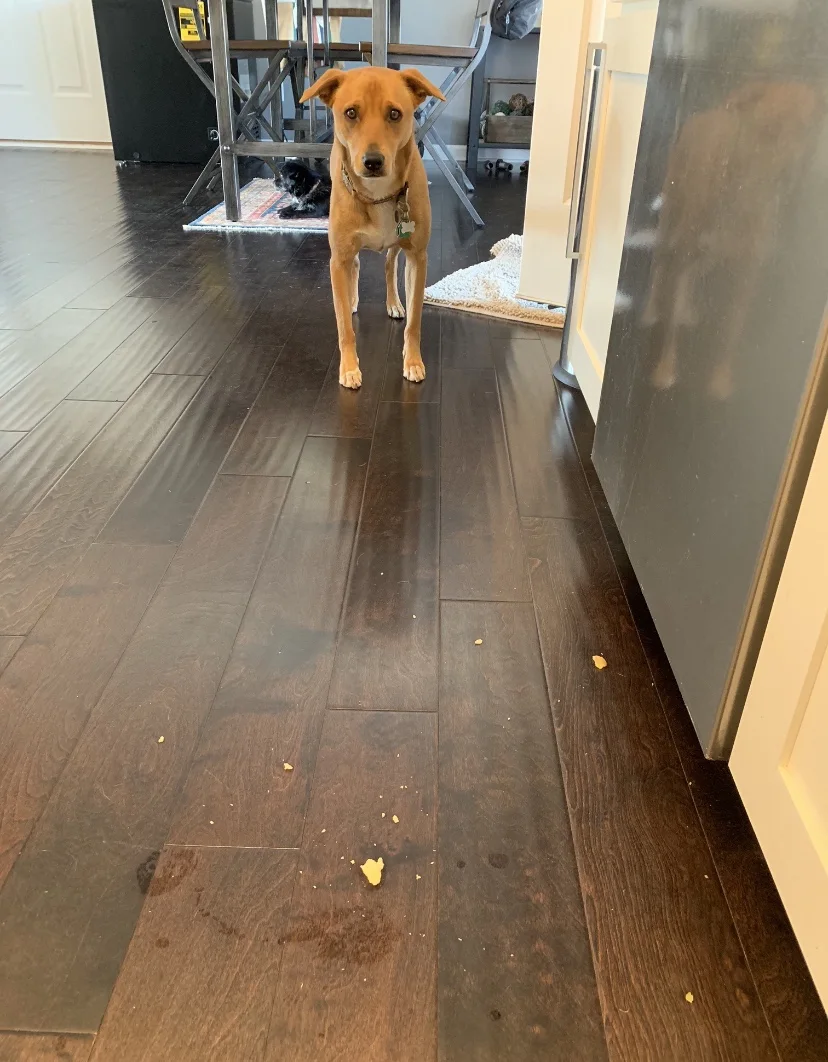
Tips to keep your dog out of the trash
- Don’t leave the trash can within your dog’s reach. Place it inside the pantry, laundry room, under the kitchen sink or into the garage.
- Buy a trash can with a lid if you can’t place it outside of your dog’s reach. Additionally, you could equip it with a child-proof lid lock. My mastiff clients use it on their trash can and it’s highly effective.
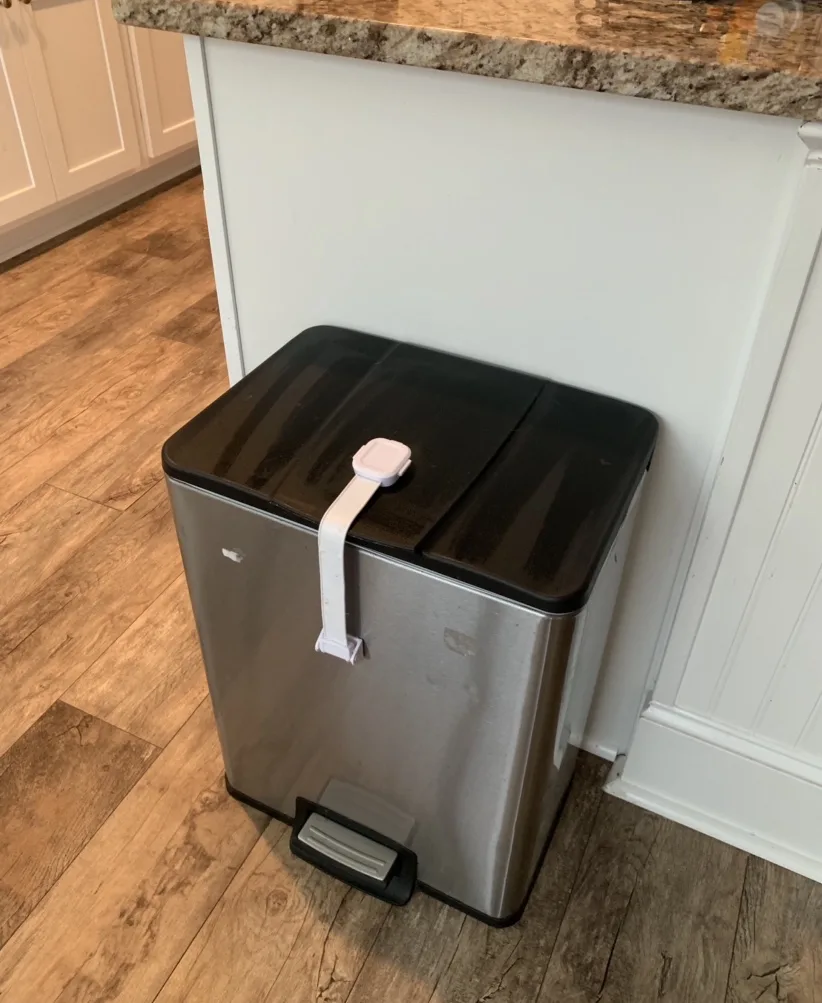
Using an e-collar to stop counter surfing
Since all dogs are different, the methods mentioned so far might not work for some. Dogs who are stubborn or who are not responding to other tools might respond well to an electric collar, also referred to as e-collar or shock collar.
These collars emit an electric beep or vibration that’s activated with a remote and are used as deterrents. The vibration can be adjusted to different levels of correction intensity, ranging from a tone to a low vibration to a low static correction.
There are a lot of e-collar brands to choose from, and we recommend you choose one on the higher end because it will be reliable and will work properly. Lindsay prefers Sport Dog and Garmin brands.
How to stop counter surfing with the e-collar
In our counter surfing situation, you would use the e-collar to correct the unwanted behavior of counter surfing. This translates into triggering a tone, vibration or correction whenever your dog is about to jump onto the counter or put his paws up.
Start with simply a tone or a low vibration. Then reward your dog when his paws are on the ground. Good boy! If your dog doesn’t respond to the lower settings, slowly work your way up in intensity.
The e-collar should only be used as a temporary solution while you’re training your dog to understand the concept of respecting the counter space. And of course, an e-collar is not necessary for a lot of dogs. It’s one option to consider.
This method is only going to work when you’re home with your dog and can actively supervise your dog. Always take the e-collar off when your dog is home alone. This is also a good opportunity to charge the collar.
More on e-collar training
Tip: The use of an e-collar to correct counter surfing might be a good solution for deaf dogs who won’t be able to hear your verbal commands and any other loud sounds.
Caution: If your dog suffers from seizures, don’t use an e-collar on him for training and/or correcting behavioral purposes.
For more info on e-collar training, see Lindsay’s posts:
When to train with a shock collar
Teaching dog to come when called with e-collar
Stop counter surfing by using mouse traps
If your dog is as determined and audacious as the pup in the video below, you may want to think outside of the box and resort to some more drastic deterring measures. Of course, we mentioned several other ideas to try first such as simply crating your dog or using a squirt bottle of water.
Some dogs simply can’t be crated and you may need to get creative about keeping them off the counters for their own safety. If this is the case, we recommend using child locks on your cabinets and trash bin as mentioned earlier.
One idea is to put up mouse traps upside down onto the kitchen counter and/or dining table when your dog is home alone. This can be a solution for extra stubborn dogs, especially larger dogs.
Mouse traps are not our top choice, but it’s a common training suggestion that comes up so we wanted to address it. The sound of the trap going off will ideally startle the dog, making him think twice about jumping onto the counters again.
An alternative approach is to stack a bunch of aluminum soda cans on your countertop. If your dog bumps into them, the sound of the cans may startle him.
Pros & cons of traditional mouse traps:
- Highly effective
- Low cost (64 pack for under $30)
- Could cause pain if it hits just right but will likely only startle the dog
- Smart dogs will learn to simply walk around the mouse trap and continue counter surfing
There are alternatives to the traditional mouse traps that are designed specifically for dog training.
The ht-pet Snappy Trainer Pet Deterrent for instance features a large paddle that quickly lifts up when brushed up against and makes a very loud snapping sound. It won’t hurt the dog, but it’s more expensive than traditional mouse traps. A 2 pack costs around $10.00.
Here’s a recap of what to keep in mind when keeping your dog from counter surfing:
- Exercise your dog on a daily basis to keep him from getting bored
- Don’t leave any food out
- Consider crate training your dog combined with dog food puzzles and safe chews
- Teach him the place command
- Create physical boundaries around the counter and dining table with gates or closed doors
- Correct counter surfing with the tools we mentioned such as loud sounds, spray bottles, aluminum foil, sticky tape, upside down mouse traps, or e-collar training
We’d like to hear from you!
Does your dog like to counter surf or jump onto the dining table? How did you try to fix the problem?
If you have any questions, let us know in the comments!
Barbara Rivers writes regularly for That Mutt. She is certified in raw dog food nutrition from Dogs Naturally Magazine and the author of three ebooks about balanced raw dog food. She is a blogger at K9s Over Coffee.

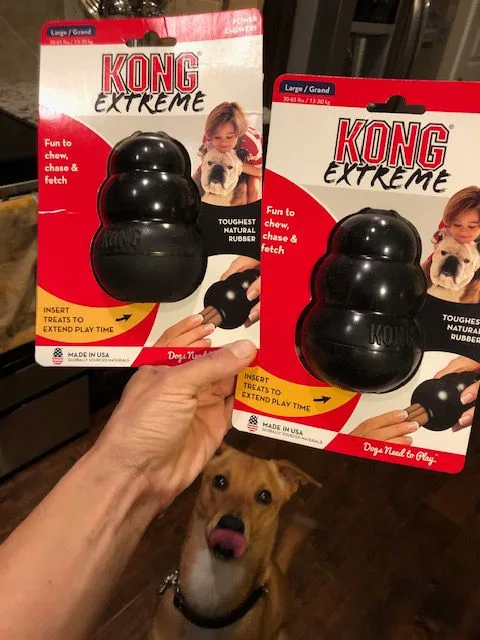
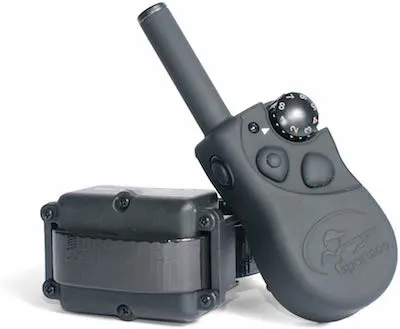
Matt
Monday 2nd of December 2019
What a great article, for me, it came down to thinking about what I was doing. I didn't leave a jar of treats on the counter, it was in a cabinet he couldn't get to. I never left food out, it was in containers and put in the fridge. I found he would try to get on the counter after I had made dinner, he could smell what was on the counter. I changed my cleaning products to help eliminate the smell. I do like the idea of putting coins in pop cans to make noise, that's a great idea.
Rohna Hartenstein
Tuesday 29th of October 2019
I stopped my pup from jumping up to the counter by strategically placing a few coin filled soda cans (very noisy) on the edge of the counter near the food she was anxious to get. One or two jumps resulted in very LOUD crashes as the cans fell down and my pup left the food alone.
Lindsay Stordahl
Wednesday 30th of October 2019
Yes, that is a great way to do it!
Kim Chappell
Monday 28th of October 2019
Another great article, thank you for sharing! Also congrats on your new book being sold by Amazon!
The baby locks for cabinets and garbage cans are a great idea!
I primarily use remote collars for achieving clear communication between humans and canines. Counter surfing is one of the few times I use a higher stimulation on the collar, as counter surfing can be life threatening for a dog. The remote collar is in my opinion the most effective tool to stop counter surfing. The consequence has to be high enough that the dog will stop the behavior. Be sure to use a quality remote collar, as inexpensive remotes can be unreliable. I also recommend using a baby monitor or security camera set up so you can be in the other room or outside and correct the dog.
Lindsay Stordahl
Tuesday 29th of October 2019
Thank you, Kim!